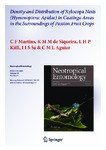Use este identificador para citar ou linkar para este item:
http://www.alice.cnptia.embrapa.br/alice/handle/doc/991128Registro completo de metadados
| Campo DC | Valor | Idioma |
|---|---|---|
| dc.contributor.author | MARTINS, C. F. | pt_BR |
| dc.contributor.author | SIQUEIRA, K. M. M. de | pt_BR |
| dc.contributor.author | KIILL, L. H. P. | pt_BR |
| dc.contributor.author | SÁ, I. I. S. | pt_BR |
| dc.contributor.author | AGUIAR, C. M. L. | pt_BR |
| dc.date.accessioned | 2017-04-26T23:48:43Z | - |
| dc.date.available | 2017-04-26T23:48:43Z | - |
| dc.date.created | 2014-07-22 | pt_BR |
| dc.date.issued | 2014 | pt_BR |
| dc.identifier.citation | Neotropical Entomology, v. 43, n. 4, p. 314-321, 2014. | pt_BR |
| dc.identifier.uri | http://www.alice.cnptia.embrapa.br/alice/handle/doc/991128 | pt_BR |
| dc.description | Due to their importance as pollinators of many plant species, this study aimed to know the nest density, spatial distribution, and nesting substrates used by Xylocopa species in the Caatinga, a xerophilous vegetation f Northeastern Brazil. Three areas of Caatinga in the surroundings of passion fruit crops were sampled. The bee species found in these areas were Xylocopa grisescens Lepeletier and Xylocopa frontalis (Olivier). All nests were in Commiphora leptophloeos (Burseraceae) trees (n=113). Phytosociological analysis showed that this tree species presented the highest absolute density (212.5 individuals/ha) and index of importance value (52.7). The distribution pattern of the C. leptophloeos was aggregated. The nests were located in dead and dried branches with an average diameter of 5.3±2.0 cm (n=43). The mean number of nests/tree was 3.1± 2.8 (n=113). The less disturbed area showed 6.7 nests/ha and 4.2 nests/tree. In the disturbed areas, 0.9 nests/ha and 2.4 to 2.7 nests/tree were observed. The availability of substrate for nesting in the studied areas and its importance as a limiting factor for nesting are discussed | pt_BR |
| dc.language.iso | eng | eng |
| dc.rights | openAccess | eng |
| dc.subject | Ninho agregação | pt_BR |
| dc.subject | Densidade ninho | pt_BR |
| dc.subject | Vegetação xerófila | pt_BR |
| dc.subject | Bee | pt_BR |
| dc.subject | Passion fruit | pt_BR |
| dc.title | Density and distribution of Xylocopa nests (Hymenoptera: Apidae) in Caatinga areas in the surroundings of Passion fruit crops. | pt_BR |
| dc.type | Artigo de periódico | pt_BR |
| dc.date.updated | 2017-04-26T23:48:43Z | pt_BR |
| dc.subject.thesagro | Abelha | pt_BR |
| dc.subject.thesagro | Polinização | pt_BR |
| dc.subject.thesagro | Maracujá | pt_BR |
| dc.subject.thesagro | Caatinga | pt_BR |
| dc.subject.thesagro | Inseto | pt_BR |
| dc.subject.nalthesaurus | Pollinators | pt_BR |
| dc.subject.nalthesaurus | Xylocopa | pt_BR |
| riaa.ainfo.id | 991128 | pt_BR |
| riaa.ainfo.lastupdate | 2017-04-26 | pt_BR |
| dc.identifier.doi | 10.1007/s13744-014-0221-1 | pt_BR |
| dc.contributor.institution | Universidade Federal da Paraíba; UNEB; LUCIA HELENA PIEDADE KIILL, CPATSA. | pt_BR |
| Aparece nas coleções: | Artigo em periódico indexado (CPATSA)  | |
Arquivos associados a este item:
| Arquivo | Descrição | Tamanho | Formato | |
|---|---|---|---|---|
| Kiill2014.pdf | 1.62 MB | Adobe PDF |  Visualizar/Abrir |









